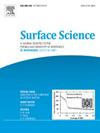o掺杂体系中外加双轴应变对单层GeS光电性能的影响
IF 1.8
4区 化学
Q3 CHEMISTRY, PHYSICAL
引用次数: 0
摘要
在这项研究中,我们应用第一性原理计算系统地研究了氧掺杂和双轴应变对单层GeS材料物理性能的协同调节。理论计算表明,氧掺杂改善了体系的电荷均匀性,应变增强降低了轨道杂化程度,增强了电子离域;掺杂使材料的带隙变宽,在拉伸应变为2%时达到最大值,随着应变的增加而缩小,在压缩应变下单调减小。差分电荷密度分析表明,拉伸应变削弱了Ge-O键的电子重构型,降低了键合强度,减弱了跳变偶极矩;压缩应变增强了电子积累和轨道耦合,提高了材料对低能光的响应性。吸收光谱表明,双轴应变减小,吸收峰蓝移,反映了带隙的变宽,而压缩应变增强,吸收峰红移;在反射光谱中,拉伸应变使反射峰减弱,而压缩应变使反射强度增强。该研究为二维GeS材料的能带工程以及柔性光电器件和可调谐光谱传感器的应用提供了理论基础。本文章由计算机程序翻译,如有差异,请以英文原文为准。

Effect of applied biaxial strain in O-doped system on the optoelectronic properties of monolayer GeS
In this study, we apply first-principle calculations to systematically investigate the synergistic regulation of physical properties of monolayer GeS materials by oxygen doping and biaxial strain. Theoretical calculations show that oxygen doping improves the charge uniformity of the system, and the strain enhancement reduces the degree of orbital hybridization and enhances the electron delocalization; doping broadens the bandgap of the material, which reaches a maximum at 2 % tensile strain, shrinks with increasing strain, and decreases monotonically under compressive strain. Differential charge density analysis shows that the tensile strain weakens the electronic reconfiguration of Ge-O bonds, reduces the bonding strength, and weakens the jump dipole moment; the compressive strain enhances the electron accumulation and orbital coupling, and improves the responsiveness of the material to low-energy light. The absorption spectra show that the biaxial strain decreases and blueshifts the absorption peaks, reflecting the broadening of the bandgap, while the compressive strain strengthens and redshifts the absorption peaks; in the reflectance spectra, the tensile strain diminishes the reflection peaks, while the compressive strain strengthens the reflection intensity. The study provides a theoretical basis for the energy band engineering of two-dimensional GeS materials as well as the application of flexible optoelectronic devices and tunable spectral sensors.
求助全文
通过发布文献求助,成功后即可免费获取论文全文。
去求助
来源期刊

Surface Science
化学-物理:凝聚态物理
CiteScore
3.30
自引率
5.30%
发文量
137
审稿时长
25 days
期刊介绍:
Surface Science is devoted to elucidating the fundamental aspects of chemistry and physics occurring at a wide range of surfaces and interfaces and to disseminating this knowledge fast. The journal welcomes a broad spectrum of topics, including but not limited to:
• model systems (e.g. in Ultra High Vacuum) under well-controlled reactive conditions
• nanoscale science and engineering, including manipulation of matter at the atomic/molecular scale and assembly phenomena
• reactivity of surfaces as related to various applied areas including heterogeneous catalysis, chemistry at electrified interfaces, and semiconductors functionalization
• phenomena at interfaces relevant to energy storage and conversion, and fuels production and utilization
• surface reactivity for environmental protection and pollution remediation
• interactions at surfaces of soft matter, including polymers and biomaterials.
Both experimental and theoretical work, including modeling, is within the scope of the journal. Work published in Surface Science reaches a wide readership, from chemistry and physics to biology and materials science and engineering, providing an excellent forum for cross-fertilization of ideas and broad dissemination of scientific discoveries.
 求助内容:
求助内容: 应助结果提醒方式:
应助结果提醒方式:


